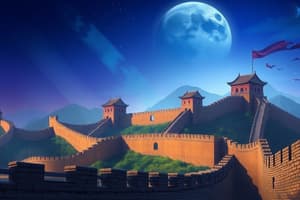Podcast
Questions and Answers
During which period did various states continue to build walls to protect themselves from neighboring kingdoms and nomadic invasions?
During which period did various states continue to build walls to protect themselves from neighboring kingdoms and nomadic invasions?
- Tang Dynasty Period
- Han Dynasty Period
- Qin Dynasty Period
- Warring States Period (correct)
Which state built a wall system that was later rebuilt by the Han state after its conquest?
Which state built a wall system that was later rebuilt by the Han state after its conquest?
- Zhao
- Zheng (correct)
- Chu
- Qi
What is the name of the permanent defense constructed by the state of Chu in the 7th century BCE?
What is the name of the permanent defense constructed by the state of Chu in the 7th century BCE?
- Hexagonal Wall
- Triangle Wall
- Circular Wall
- Square Wall (correct)
Which river marked the endpoint of the wall erected by the Qin state to protect against nomadic raids?
Which river marked the endpoint of the wall erected by the Qin state to protect against nomadic raids?
What was the primary function of the southern wall completed by the state of Zhao?
What was the primary function of the southern wall completed by the state of Zhao?
Which nomadic peoples frequently raided the Qin state, leading to the construction of their wall?
Which nomadic peoples frequently raided the Qin state, leading to the construction of their wall?
What was the purpose of the Great Wall of China during the Yan state?
What was the purpose of the Great Wall of China during the Yan state?
Which dynasty is known for the most extensive and well-preserved version of the Great Wall, running approximately 5,500 miles?
Which dynasty is known for the most extensive and well-preserved version of the Great Wall, running approximately 5,500 miles?
What did Shihuangdi order in 221 BCE that contributed to the unification of China?
What did Shihuangdi order in 221 BCE that contributed to the unification of China?
What UNESCO recognition does the Great Wall of China have?
What UNESCO recognition does the Great Wall of China have?
What is the total length of ramparts or trenches associated with the remains of the Great Wall?
What is the total length of ramparts or trenches associated with the remains of the Great Wall?
Why is the Great Wall of China considered an outstanding example of ancient Chinese culture?
Why is the Great Wall of China considered an outstanding example of ancient Chinese culture?
Flashcards are hidden until you start studying
Study Notes
The Great Wall of China: An Ancient Defense System
The Great Wall of China is an extensive fortification system built over centuries to protect China's territory. This historic structure, which stretches for thousands of miles along China's northern border, is one of the largest construction projects in ancient China's history.
Origins
The origins of the Great Wall can be traced back to the 7th century BCE, when the state of Chu began constructing a permanent defense known as the "Square Wall" in the northern part of its capital province. Other states, such as Qi, followed Chu's example, gradually creating extensive perimeter walls using existing river dikes, newly constructed bulwarks, and impassable mountain terrain.
Warring States Period
During the Warring States period (475-221 BCE), various states continued to build walls to protect themselves from neighboring kingdoms and nomadic invasions. For example, the state of Zheng built a wall system, which was later rebuilt by the Han state after it conquered Zheng. The state of Zhao completed a southern wall and a northern wall, with the southern wall primarily serving as a defense against the Wei state. The Qin state, which grew politically and militarily to become the strongest among the seven states, faced frequent raids from nomadic peoples, such as the Donghu and Loufan. In response, the Qin erected a wall that started from Lintiao and went north along the Liupan Mountains, ending at the Huang He (Yellow River). During the Yan state, two separate defensive lines were prepared—the Northern Wall and the Yishui Wall—to defend against attacks by northern groups.
Unification of China
In 221 BCE, Shihuangdi, the first emperor of a united China, ordered the removal of fortifications between the previous states and connected a number of existing defensive walls into a single system. The wall was left largely ungarrisoned and fell into disrepair after the fall of the Qin dynasty following Shihuangdi's death.
Reconstruction
The Great Wall was rebuilt and expanded during the Han, Northern Qi, Jurchen-ruled Jin, and particularly the Ming dynasties. The Ming dynasty (1368-1644) is known for its most extensive and well-preserved version of the wall, which runs for approximately 5,500 miles (8,850 km) east to west.
The Great Wall as a UNESCO World Heritage Site
The Great Wall of China is considered one of the new Seven Wonders of the World and is a UNESCO World Heritage Site. It is an outstanding example of the superb military architecture, technology, and art of ancient China, reflecting the collision and exchanges between agricultural civilizations and nomadic civilizations in ancient China.
Integrity and Significance
The Great Wall integrally preserves all the material and spiritual elements, historical and cultural information, and national and cultural significance to China. The remains of the Great Wall associated sites include 10,176 ramparts or trenches, 29,510 individual buildings, and 2,211 fortifications or passes, with the walls and trenches spanning a total length of 21,196.18 km (13,170.70 mi).
The Great Wall Today
Today, the Great Wall of China is a popular tourist attraction, attracting millions of visitors each year. It is a testament to the political strategic thinking and military might of ancient China and serves as a symbol of China's past and present strength.
Studying That Suits You
Use AI to generate personalized quizzes and flashcards to suit your learning preferences.




